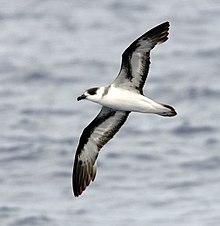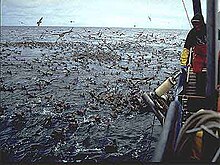Petrels
| Petrels | ||||||||
|---|---|---|---|---|---|---|---|---|

White-chin petrel ( Procellaria aequinoctialis ) |
||||||||
| Systematics | ||||||||
|
||||||||
| Scientific name | ||||||||
| Procellariidae | ||||||||
| Leach , 1820 |
The petrels (Procellariidae) are a family of birds from the order of the tubular noses (Procellariiformes). The family includes 93 species in 16 genera. It is a species-rich group of mostly medium-sized deep-sea birds that is distributed over all oceans, but above all in the southern hemisphere. This gives them one of the largest ranges of all bird families. The southernmost species is the snow petrel , which breeds in Antarctica. The northernmost common species is the fulmar .
features
Like other tube noses, petrels are characterized by two tube-like nostrils on the top of their beak through which sea salt and stomach oil can be excreted. The beak is long and hook-shaped, has a nail-like tip and very sharp edges. This texture helps to hold slippery prey like fish better.
The size is very variable. The smallest shearwater is 25 cm long, has a wingspan of 60 cm and a weight of 170 g (minimum dimensions). Most species are only marginally larger. The only exceptions are the giant petrels, which are reminiscent of small albatrosses - they can be 1 m long, reach a wingspan of 2 m and weigh 5 kg.
The plumage is colored white, gray, brown or black. Only a few species are consistently dark in color. Most species are dark on the top and light on the underside. All species are quite inconspicuous. Some species are so similar that they cannot be distinguished from one another when observed in the field. There is no visible sexual dimorphism , apart from the slightly smaller average sizes of the female birds. In many species, the two sexes have different vocalizations.
All petrels are very good fliers, but have different flight styles depending on the species. The legs, on the other hand, are weak and close to the back of the body. They are unsuitable for walking, so a petrel on land has to support itself with its chest and use its wings to help.
Way of life
Outside of the breeding season, they spend their entire life on the high seas and are able to adapt to even the most difficult weather conditions. Their diet is consistently carnivorous . Most eat small fish and marine invertebrates such as octopus, which they prey from just below the surface of the sea. A few live on plankton and others also eat carrion - such as dead whales floating in the sea. The latter species now often feed on the waste from the fishing fleets. The population of these species has profited greatly from the expansion of fisheries and some of them have increased their populations.
Petrels usually breed in large colonies near coastlines, often on steep cliffs or scree slopes. They lay a single egg, which has a white shell and is unusually large in relation to the bird. The breeding season is between 40 and 60 days, with the smaller species the hatched chick flies after 45 to 55 days, with the largest species this can take 100 to 135 days.
Systematics
External system
The petrels are run as a family within the tube noses . They are the sister group of the diving petrels here , and both together form the sister group of the albatrosses .
Internal system
Petrels are traditionally divided into four subfamilies, which, however, are not systematic groups according to more recent research. They each have some common features, but these do not always suggest an actual relationship. These groups are:
Seagull petrels

As the only one of the four classical subfamilies, the seagull petrels (Fulmarinae) are apparently actually a monophyletic group. They are grouped together based on typical features of their skull and particularly large nasal tubes. The best known species is the fulmar, which is the only seagull petrel north of the equator .
- Giant Petrels ( Macronectes )
- Giant Petrel ( M. giganteus )
- Hall petrel ( M. halli )
-
Fulmarus
- Fulmar ( F. glacialis )
- Silver petrel ( F. glacialoides )
-
Thalassoica
- Antarctic petrel ( T. antarctica )
-
Daption
- Cape petrel ( D. capense )
-
Pagodroma
- Snow petrel ( P. nivea )
Hook shearwaters and relatives
With 39 species, the Pterodrominae are the largest of the classical subfamilies. They live in tropical and temperate latitudes. Flight, a change from glide phases and hectic wing beats is typical for them. Their food is mainly squid , which they prey near the surface of the water. They rarely go into hiding completely, so that their German name seems rather inappropriate. The English name, "gadfly petrels", is derived from brakes , the flight of which they reminded the namesake.

- Hook shearwater ( Pterodroma ), with 32 species
-
Lugensa
- Kerguelen petrel ( L. brevirostris )
-
Pseudobulweria , with 4 kinds
- Solomon Petrel ( P. becki )
- Mascarene petrel ( P. aterrima )
- Macgillivray petrel ( P. macgillivrayi )
- Tahitian petrel ( P. rostrata )
-
Bulweria
- Jouanin's petrel ( B. fallax )
- Bulwer's petrel ( B. bulwerii )
-
Halobaena
- Blue petrel ( H. caerulea )
Whale birds
The whale birds (Pachyptilinae, Pachyptila ), also known as duck petrels, comprise only one genus with six species that differ significantly from the other petrels. Their beak has been converted into a filter instrument that they can use to plow through the water and eat plankton . Because of the distant resemblance to the whales of the baleen whales , the birds bear their name. The genus includes the following six species:
- Great duck petrel ( Pachyptila vittata ). The beak of this species is steel-gray above and bluish-yellow below.
- Small duck petrel ( Pachyptila salvini ). Here the beak is bluish-gray above and below.
- Pigeon petrel ( Pachyptila desolata ), which breeds on the Antarctic Peninsula and on Kerguelen and Heard , among other places .
- Belcher petrel , also thin-billed whale bird ( Pachyptila belcheri ). The Belcher petrel is characterized by a long, very narrow beak.
- Fairy petrel ( Pachyptila turtur )
- Thick-billed petrel ( Pachyptila crassirostris ), which differs from the other whale birds by a thickened beak plate.
Shearwater and relatives
Depending on the species, the Procellariinae are adapted to varying degrees to chase after their prey by diving. A denser plumage and wider wings are adaptations to this way of life. They often fly so close to the surface that they appear to be touching the water. Many form large colonies.


-
Procellaria
- White-chin petrel ( P. aequinoctialis )
- Gray petrel ( P. cinerea )
- Procellaria conspicillata
- Parkinson's petrel ( P. parkinsoni )
- Westland petrel ( P. westlandica )
-
Calonectris
- Yellow-billed Shearwater ( C. diomedea )
- Cape Verde Shearwater ( C. edwardsii )
- White-faced shearwater ( C. leucomelas )
-
Shearwater ( Puffinus ), with 19 species (selection):
- Lesser Shearwater ( P. assimilis )
- Gray-necked Shearwater ( P. bulleri )
- Pink-footed Shearwater ( P. creatopus )
- Great Shearwater ( P. gravis )
- Dark Shearwater ( P. griseus )
- Audubon shearwater ( P. lherminieri )
- Balearic Shearwater ( P. mauretanicus )
- Christmas shearwater ( P. nativitatis )
- Wedge-tailed shearwater ( P. pacificus )
- Short-tailed shearwater ( P. tenuirostris )
- Levantine Shearwater ( P. yelkouan )
- Atlantic shearwater ( P. puffinus )
Modern systematics
More recently, various studies have examined whether the individual subfamilies actually correspond to related groups, i.e. real taxa . The most significant of these studies were undertaken by Nunn and Stanley, as well as Bretagnolle and others, who came to broadly similar results.
According to this, only the gull petrels are confirmed as a monophyletic group. The Pterodrominae were found to be paraphyletic in relation to the whale birds and two genera of the shearwater. The Procellariinae were not only revealed as polyphyletic , their main genus Puffinus was also recognized as paraphyletic in relation to Calonectris . From all these findings it follows that at least Procellariinae and Pterodrominae are pure form taxa without systematic value.
A cladogram of the petrel genera looks like this:
| Petrels (Procellariidae) |
|
|||||||||||||||||||||||||||||||||||||||||||||||||||||||||||||||||||||
|
|
Man and petrels
Some petrel species play a minor role in the human diet. Because of their tasty meat, they are called "Muttonbirds" (= mutton birds) in English. The young of the short-billed shearwater and the dark shearwater, who have not yet left the nest, come onto the market as "Tasmanian young pigeons". Both species have very high populations and fixed catch quotas are intended to prevent catching for human consumption from negatively affecting the population. In 2004 the Convention for the Protection of Albatrosses and Petrels ( ACAP ) , currently signed by 13 countries, came into force.
literature
- Michael Brooke: Albatrosses and Petrels Across the World. Oxford University Press, 2004, ISBN 0-19-850125-0 .
- Josep del Hoyo et al. a .: Ostrich to Ducks. Lynx, Barcelona 1992, ISBN 84-87334-10-5 (Handbook of the Birds of the World, Vol. 1).
- Peter H. Barthel, Paschalis Dougalis: What is flying there? Kosmos, Stuttgart 2006, ISBN 978-3-440-09977-3 .
- PJ Higgins (Ed.): Handbook of Australian, New Zealand & Antarctic Birds. Volume 1, Ratites to Ducks, Oxford University Press, Oxford 1990, ISBN 0-19-553068-3 .
supporting documents
- ↑ David W. Winkler, Shawn M. Billerman, Irby J. Lovette: Bird Families of the World: A Guide to the Spectacular Diversity of Birds. Lynx Edicions (2015), ISBN 978-8494189203 . Page 168.
- ↑ Christopher M. Perrins (ed.): The BLV encyclopedia birds of the world. Translated from the English by Einhard Bezzel. BLV, Munich / Vienna / Zurich 2004, ISBN 978-3-405-16682-3 , p. 71 (Title of the original English edition: The New Encyclopedia Of Birds. Oxford University Press, Oxford 2003).
- ^ A b Gary Nunn, Scott Stanley: Body size effects and rates of cytochrome b evolution in tube-nosed seabirds. In: Molecular Biology and Evolution. No. 15, 1998, pp. 1360-1371
- ↑ V. Bretagnolle, C. Attié, E. Pasquet: cytochrome B evidence for validity and phylogenetic relationships of Pseudobulweria and Bulweria (Procellariidae). In: The Auk. No. 115, 1998, pp. 188-195
- ↑ Christopher M. Perrins (ed.): The BLV encyclopedia birds of the world. Translated from the English by Einhard Bezzel. BLV, Munich / Vienna / Zurich 2004, ISBN 978-3-405-16682-3 , p. 72.
Web links
